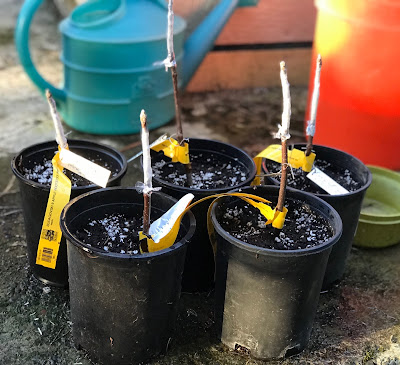 |
| This is the first step of wrapping the graft with plastic strip. Knot tied. |
 |
| The strip is flattened, wrapped tightly up, then down, and tied again. |
 |
| Finally, the scion is wrapped to avoid dehydration. I used parafilm this time. |
Today I grafted new scions onto a number of pre-existing apple trees. I'm comfortable with whip and tongue grafting, so that's what I do. These trees are young but starting to have some size. They are dwarf or semidwarf size trees. For one, a large, mature branch of Pristine broke due to graft failure, so I'm not grafting Pristine back onto that tree. There is a small "water sprout" branch near that location, so I grafted a new variety to that branch as a replacement ("Bob's red flesh, a small apple with red flesh throughout).
I thought I would show my current method. It's much easier than the older methods that involved grafting wax and string, or sticky tape. I use strips, about 3/4 inch wide, cut from gallon-size "Ziplock" plastic freezer bags. After experimenting with stretching, I can get a good firm tight binding, without breaking the strips.
The cutting and fitting of the scion and understock is as usual. I didn't do as fine a job as last year, but apple is fairly forgiving, so I think they should take. Once the whip and tongue graft scion and understock are fitted together, I tie a strip of plastic strip below the graft, with one end being short and the other long.
Then I flatten the strip, and wrap up, then down the graft. I pull the plastic strip as firm as I can, without stretching to the yield point where it loses it's stretch and tears.
Then I tie the end of the strip back to the original knot.
I wrap the scion with either a thinner plastic strip, or this time, parafilm. The goal there is to prevent dehydration but allow the buds to grow
This method gave 100% take last year. I'm hoping for a good result this year too.
I grafted -
That "
Bill's Red Flesh".
A local crab apple variety from an HOS member, "
Hi Jack".
Pristine.
I also bought some Bud-9 rootstock at the HOS show, and grafted
Northpole apple onto that rootstock. I want to see if I can better limit the height, and make a much more compact columnar apple tree than I have with the original
Northpole.
And quince varieties, to the quince tree that I'm reworking, adding
Limon and
Crimea Quince cultivars.
Also, onto a plum branch, I added one branch from an ornamental, fastigiate red plum (Scarlet Sentry?) from elsewhere in the yard, for pollination purposes. That goes both ways - I'm curious to see if those plums are larger or better set, when pollinated by more proximal plum varieties.

























